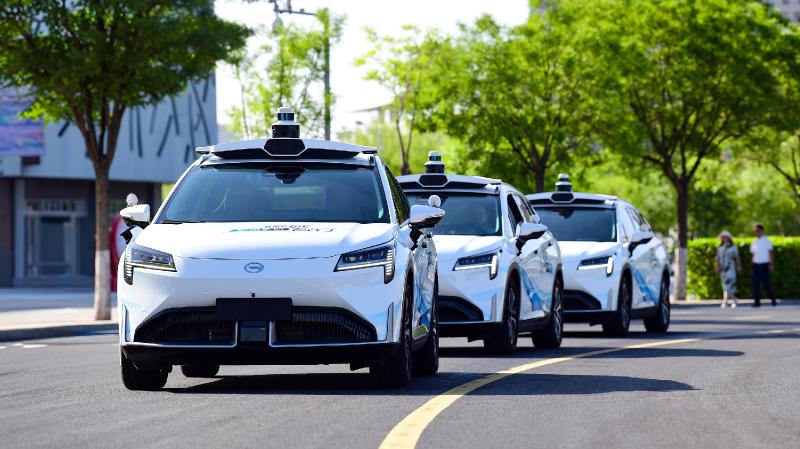The robotaxis have arrived
By: Kristin Houser (Freethink)


Sorry, I'm not buying the hype. I've seen autonomous mine trains, airport buses, shop floor trolleys, driverless people movers in the 1980s. Humans are quite capable of accommodating the limitations of simple autonomous machines. Attempting to create machines that will accommodate the irrational vagaries of human desires will be both exorbitantly expensive and constantly deficient.

It's 2025, and you just rode in a robotaxi for the first time. Getting a ride was as easy as hailing a Lyft, and the ride itself was better: you controlled the music and didn't need to make small talk. Thanks to the superhuman tech under the hood, the trip was also safe.
Robotaxis
If you decided to buy a new car today, chances are the vehicle you'd drive off the lot would have some autonomous capabilities — it might be able to parallel park itself, for example, or hit the brakes if the car in front of you suddenly slows.
For the foreseeable future, though, if you want to check your emails or catch a few Zs on your way to work, your only option might be to hail a robotaxi owned and operated by someone else.
To find out why the most autonomous vehicles (AVs) on the road today are ones you can't own, let's take a look back at the history of AVs and the companies competing to shape the burgeoning robotaxi market.
Where we've been

Where we're going (maybe)
An estimated 45 million people visited General Motors' Futurama exhibit at the World's Fair, and as they took in the scale model of tomorrow's world, a narrator told them how automated cars on superhighways were going to make transportation faster and safer by 1960.
At the time, this vision seemed both fantastical and incredibly possible — the Great Depression was ending, car ownership was once again on the rise in the US, and the government was already considering how to build an interstate highway system. The pace of technological change and industrial innovation made the future seem so close.
By the time 1960 actually rolled around, the nation was even more car-centric than Futurama predicted. Construction of the interstate highway system was speeding along at a record pace, and there were 74.4 million cars on the road — nearly double the 38 million GM had anticipated.
Not one of those cars was autonomous, though. It turned out that equipping a car with the tech needed to drive itself was an even bigger challenge than building thousands of miles of roads or convincing people to trust each other behind 100-horsepower engines.
America still isn't ready to give up on the dream of 1939, though.
Dozens of startups and veteran automakers are developing automated driving systems, and while no one has managed to develop an AV that could drive us anywhere, anytime, some of the most advanced systems can work without human oversight under certain conditions.
These achievements haven't come cheap. AV industry leader Waymo has spent billions of dollars on R&D, and the hardware alone in each of its robotaxis reportedly costs $100,000. It's going to cost even more to advance the technology, and some experts think we're never going to get to the point that AVs work everywhere, all the time.
The question, then, is what are AV developers to do with cars that can only operate autonomously under certain conditions, but that still cost a lot of money to build, develop, and maintain?
The answer may be to turn them into robotaxis.
 Waymo
WaymoInstead of trying to sell autonomous cars directly to consumers, Waymo, Cruise (a GM subsidiary), Zoox (an Amazon subsidiary), and other AV developers plan to use their vehicles like self-driving Ubers or Lyfts, providing rides to customers on demand once hailed via apps.
This gives developers control over where and how their AVs are used, helping avoid some potential liability issues — Tesla has been sued multiple times for allegedly not being clear enough with drivers about the capabilities of its Autopilot system, leading to misuse and accidents.
Because the AVs themselves are on the road a lot more than private cars tend to be, the robotaxi model also gives developers the opportunity to collect more data — the kind needed to improve the systems — more quickly.
It also allows them to generate revenue continuously from the expensive vehicles, rather than having them mostly sit parked in driveways and lots. It may not be enough to offset R&D or hardware costs right now, but if the robotaxi industry grows the way manyexpertspredict, the market could end up being huge.
"Waymo's mission is to be the world's most trusted driver, first and foremost." A Waymo spokesperson
These predictions about the future of robotaxis seem pretty plausible, too.
There's a growing demand for ridehailing services from companies like Uber and Lyft, and while the commercial robotaxi market essentially consists of just one company right now — Waymo — it has been steadily expanding its service area since launching in 2018.
As we learned from Futurama, though, plausible doesn't mean certain, and a lot will need to go right for robotaxis to develop into a multi-billion dollar industry.
For one, developers will need to continue lowering the cost of deploying their vehicles. You need to rack up a lot of passenger miles to offset the cost of $100,000 worth of hardware per car, especially when you're also paying for the vehicle's maintenance, storage, and charging — costs that Uber and Lyft offload to human drivers.
Waymo is headed in the right direction on that front.
In August, the company announced that its 6th-generation hardware system was not only more capable, but "significantly" cheaper than the sensor suite it was currently using. Saswat Panigrahi, Waymo's chief product officer, told the New York Times that "profitability will jump further" as the company integrates AVs with these systems into its fleet.
Robotaxi companies will also need to continue expanding their service areas at just the right pace: fast enough to take advantage of any revenue opportunities, but slow enough to minimize the chance of their robotaxis being involved in accidents like the one in San Francisco that caused Cruise to recall its entire fleet of AVs in 2023.
Incidents like that one, in which a Cruise robotaxi dragged a jaywalking pedestrian for 20 feet after she was first hit by another, human-driven vehicle, can not only cause problems with regulators, but also increase public skepticism of AVs, which is already high — nearly two-thirds of Americans surveyed by Pew in 2022 said they wouldn't ride in one if given the chance.
About as many respondents said they'd feel more accepting of AVs if developers were required to regularly report accident data, though, and Waymo is already voluntarily making such information available — in September, it launched a Safety Data Hub that makes crash report data easily accessible, while also detailing how its robotaxis compare to human drivers.
"Waymo's mission is to be the world's most trusted driver, first and foremost," a Waymo spokesperson told Freethink. "The Waymo Driver avoids collisions better than even an always-attentive human driver, preventing more crashes and reducing the severity of injuries."
Waymo is now working to expand its lead in the robotaxi industry, with commercial deployments in Atlanta and Austin next on the agenda. Meanwhile, Amazon's Zoox is preparing to launch a commercial service in Las Vegas in 2025, and Cruise is focused on regaining regulators' trust following last year's recall and leadership shakeup.
Tesla has also joined the robotaxi conversation, with CEO Elon Musk unveiling a two-seater "Cybercab" prototype at a livestreamed event on October 10. Rather than Tesla operating these vehicles, the company expects individuals to buy them for their own use and then send them out into the world to earn money as robotaxis when they're not needed.
Because a Cybercab could only operate autonomously (it lacks a steering wheel and pedals), Tesla seems to be banking on its self-driving tech eventually being good enough to secure permission from regulators to drive owners anywhere they need to go. Either that, or it thinks owners will be willing to use an alternative mode of transportation — like an Uber or a second car — when autonomy isn't an option.
Tesla also expects this system to cost far less than the tech in Waymo's vehicles — Musk has said the Cybercab will go into production in late-2026 or 2027 and cost "less than $30,000."

Tesla's Cybercab prototype
Those are some big claims, and Musk is notorious for being overly optimistic with timelines, so for now, it seems like the safer money is on company-owned fleets of robotaxis being the future of AVs, and so far, Waymo seems to be the company making all the right moves to lead the industry.
Thanks to a recent $5 billion investment by Alphabet, it has the financial security to continue its slow and steady robotaxi rollout, too, which will hopefully help it avoid any incidents that force us to wait even longer for the autonomous future envisioned in 1939 to arrive.

Tags
Who is online
62 visitors


A fleet of completely independent autonomous vehicles could well cost more than an extensive network of simpler and less expensive technology. And the demand for perfection in independent autonomy can only drive the costs exponentially higher.
A bus can follow a guide wire embedded in the pavement. There isn't any need for an artificial brain. And the lower cost would allow deploying more of them.
Evolution at work, one way or the other. History favors the one third that take the risk.
Not only am I not climbing into a driverless car, I don’t even want to be on the road with them when I’m driving in my own car.